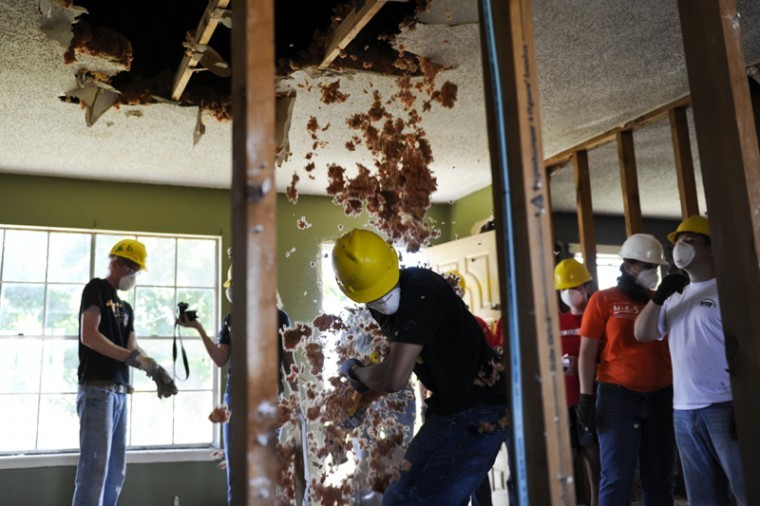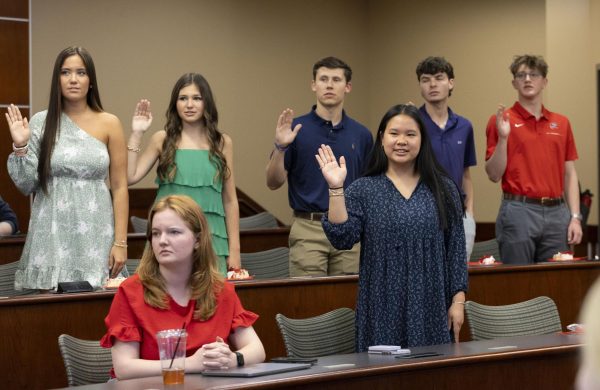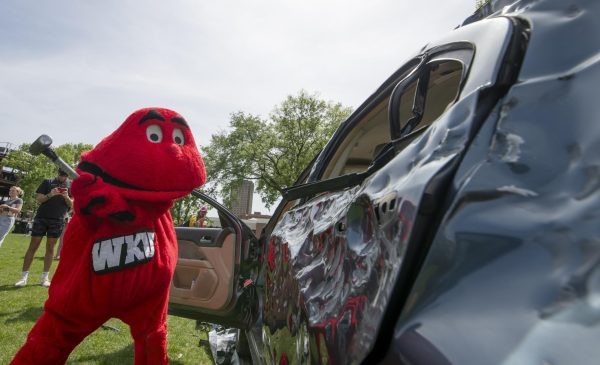WKU instructor planning more return trips to rebuild Joplin
October 9, 2011
JOPLIN, Mo. — The ground in Joplin sparkles in the sun from the shards of broken glass in the dirt.
Under the cloudless blue sky, a group of 14 volunteers from WKU — 13 students and an instructor — worked Saturday morning to strip a house, inside and outside, on Montana Place.
“Alright, who wants to demolish a ceiling?” David Serafini, history instructor and chapter advisor for Phi Sigma Pi at WKU, yelled to the group as he stepped onto the porch of the house.
The majority of the day Saturday was spent working on demolition projects for Relief Spark, a nonprofit organization assisting with relief work in Joplin, including gutting a house, removing a floor and moving debris.
Ben Tarpley, director of operations for Relief Spark in Joplin, said about 5,000 homes and 500 businesses were destroyed by the tornado, which was classified as an EF-5.
Since May 27, which is when Tarpley began work with Relief Spark, 40 homes have been gutted or demolished. In order for many properties to be rebuilt, the damaged structures must first removed.
About 80,000 volunteers have worked in Joplin in the four months since the storm — 5,000 of which came through Relief Spark, Tarpley said.
Relief Spark has committed to build 23 homes and plans to build an additional 27 or more within the next 50 months, Tarpley said.
Tarpley, a retired city manager from Dublin, Ga., compared the effect of the volunteers on the community to the “starfish story.” According to Tarpley, the story says that after a big storm, thousands of starfish were washed onto a beach, and a young boy walked along the shore, throwing the starfish back as he went.
“And after a while, an old gentleman coming the other direction met him and said, ‘Son, what are you doing?’” Tarpley said. “He says, ‘Well, I’m throwing these starfish back in the water.’ He says, ‘Well, why? I mean, look in front you — mile after mile of thousands of starfish. There’s no way you can accomplish it. What good’s gonna come from it?’ The little boy reached down and picked up a starfish and threw it in the water and looked at the older gentleman and says, ‘Well I made a difference for that one.’
“That’s about the way you have to look at it.
“Each of those groups have made a difference,” Tarpley added. “It may not have been a big difference. It may have just been a small difference. It may have been one home. It may have been one ceiling. It may have been one fence. It may have been one stump that was removed from a yard, but they made a difference.”
Around the “dead zone” in Joplin, hand-painted signs thanking the volunteers can be found on the sides of buildings and propped up against trees.
“I don’t know how much of a hero I am,” Serafini said, adding that being called a hero felt overwhelming.
Serafini organized the first trip to Joplin in June, just one month after the storm.
Now, he’s already planning a third, fourth and countless other trips back to continue to assist with rebuilding.
“There will be a Joplin Run,” he said, “for as long as Joplin needs us to run.”






















![Students cheer for Senator at Large Jaden Marshall after being announced as the Intercultural Student Engagement Center Senator for the 24th Senate on Wednesday, April 17 in the Senate Chamber in DSU. Ive done everything in my power, Ive said it 100 times, to be for the students, Marshall said. So, not only to win, but to hear that reaction for me by the other students is just something that shows people actually care about me [and] really support me.](https://wkuherald.com/wp-content/uploads/2024/04/jadenmarshall-600x422.jpg)

